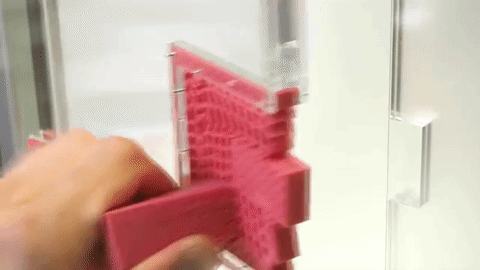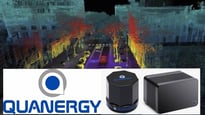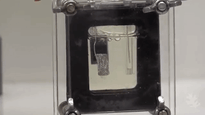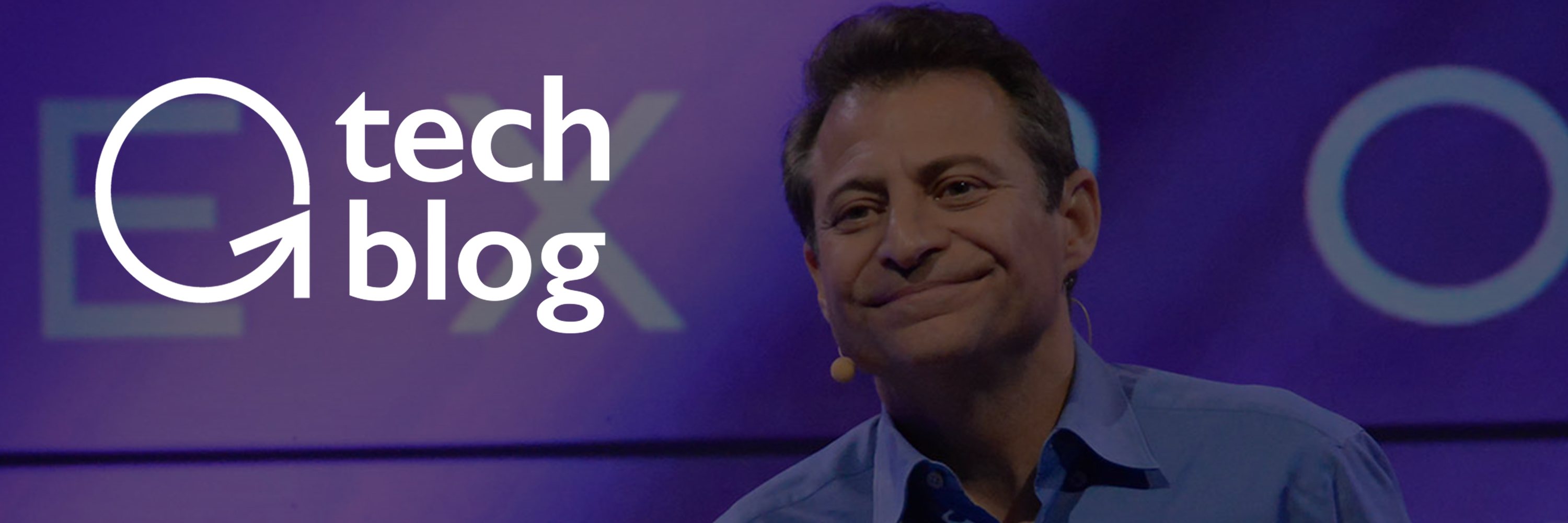
In this week's Abundance Insider: 3D printing metamaterials, Quanergy’s solid-state LIDAR sensor, and Microsoft's speech recognition breakthrough.
Cheers,
Peter, Marissa, Cody, Kelley, Greg, Sydney and AJ
P.S. Send any tips to our team by clicking here, and send your friends and family to this link to subscribe to Abundance Insider.
3D Printed Squishy Door Handle Made of Metamaterials

What it is: Researchers at Germany's Hasso Plattner Institute have refined 3D-printed metamaterial, which is a system of microstructures printed inside an object. Made from silicone cell grids, the objects created have properties not found in nature, such as controlled directional movement. Typically, 3D printed materials are solid and stiff, but metamaterial can add movement, with microstructures that expand and contract -- like the squishy door handle shown here.
Why it's important: We can currently 3D print in over 200 materials and mixed materials, and this particular breakthrough adds yet another capability to the mix. Soon, researchers will be able to make entire machines in a single print process, eliminating the need for assembly and giving even everyday objects like pliers and doorknobs unexpected functionality. | Join the Discussion
Spotted by Skye Lininger / Written by Jason Goodwin
Researchers Pinpoint Chemical They Say 'Has the Potential to Postpone Aging'

What it is: A new study from the University of Copenhagen's Center for Healthy Aging and the American National Institute of Health identified coenzyme NAD+ as the chemical that could potentially postpone physical aging in humans and even help prevent conditions like Alzheimer's and Parkinson's disease. The chemical was examined on mice and roundworms bred with Ataxia telangiectasia (A-T), an illness that hinders DNA repairs. Although the chemical's effects on humans have yet to be tested, researchers believe it could have major implications on human longevity.
Why it's important: Peter's efforts to help extend the healthy human lifespan through Human Longevity Inc. (HLI) are closely aligned with the proactive, preventative, and personalized changes we'll see in healthcare in the near future. If this chemical's effects can successfully delay the process of aging in humans, too, NAD+ could be a powerful tool in our growing longevity toolkit.
Spotted by Dan Sullivan / Written by Sydney Fulkerson
Aurora Demonstrates ALIAS Robotic System on Cessna Aircraft

What it is: Earlier this month, Aurora Flight Sciences showed off the automated flight technology in its ALIAS robotic system, using it to fly a Cessna Caravan. This marks the third different aircraft this year on which Aurora has successfully tested its technology. "Developed under contract through the Defense Advanced Research Projects Agency (DARPA), ALIAS utilizes a robotic system that functions as a second pilot in a two-crew aircraft," as Unmanned Systems Technology reports, "enabling reduced crew operations while ensuring that aircraft performance and mission success are maintained or improved."
Why it's important: Just as we're seeing brand new autonomous systems under development, we're also seeing retrofit systems that, like ALIAS, quickly transform existing vehicles and planes into autonomous cars. This enables organizations to modernize their fleet, optimize operations and ultimately surf on the wave of transportation automation. | Join the Discussion
Spotted by Rick Beasley / Written by Marissa Brassfield
Microsoft's New Speech Recognition System Achieves Human Parity in Audible Words

What it is: New technology from Microsoft recently achieved a historic milestone by reaching human parity in speech recognition. The new system performed at a word error rate of only 5.9% -- 6.3% lower than the previous month -- due to Microsoft's neural network technology, which makes the same inferences humans make when correcting for misheard words. Microsoft will continue to improve the system's accuracy in more real-world settings, like work environments, where background noise makes it difficult to recognize conversational speech. "Even five years ago, I wouldn't have thought we could have achieved this. I just wouldn't have thought it would be possible," said Harry Shum, the executive vice president who heads the Microsoft Artificial Intelligence and Research group.
Why it's important: AI is enabling truly effective human-technology teamwork. When computers can understand natural language as well as humans, as Microsoft has just demonstrated, users can interact with their AIs just as they would a trusted friend, and ultimately unshackle their own creativity. | Join the Discussion
Spotted by Cody Rapp, Dan Swift / Written by Sydney Fulkerson
Self-Driving Car Sensors Just Got Smaller, Cheaper, and Better All at Once

What it is: Quanergy is dematerializing and demonetizing self-driving car sensors with its just-announced S3 solid-state LIDAR. The S3 can scan objects in higher resolution and with greater range (200m vs 120m) than existing LIDAR sensors. Its LIDAR chip contains a million tiny antenna, capable of generating a million point cloud data points per second. Compared to the $7,999 barnacle-sized LIDAR seen on other self-driving prototypes from Uber and Alphabet, Quanergy has brought the cost of one sensor down to $250, and to a footprint similar to a point-and-shoot camera.
Why it's important: We're witnessing an explosion of sensors, and this first-ever solid state LIDAR is cheaper and better than anything currently on the market. Quanergy's S3 is already slated for a 2017 Mercedes prototype and numerous commercial vehicles in 2018. But what happens when Quanergy releases a $100 sensor the size of two matchbooks, small enough for consumer drones? How does VR content explode when I can scan my home or street for $100? | Join the Discussion
Spotted by Peter Diamandis / Written by Jason Goodwin
Scientists Accidentally Discover Efficient Process to Turn CO2 Into Ethanol

What it is: In an attempt to find a series of chemical reactions that could turn CO2 into useful fuel, scientists at the Oak Ridge National Laboratory in Tennessee unexpectedly turned CO2 into ethanol. This accidental discovery was found using a copper-carbon combination arranged into nanospikes on a silicon surface, which resulted in precise reactions with minimal contaminants. The integration of common materials with nanotechnology could potentially power vehicles and power generators, and may soon be able to remove large amounts of CO2 from the atmosphere.
Why it's important: As Peter mentioned in his blog on disrupting solar, we're rapidly heading toward a future with abundant energy. Our history is full of examples of major discoveries and breakthroughs that happened by accident -- and this particular happy accident could revolutionize energy storage from a cost and efficiency perspective. | Join the Discussion
Spotted by Daniel Trakell, Kane Kennon, Jamie McLellan / Written by Sydney Fulkerson
All Tesla Cars Being Produced Now Have Full Self-Driving Hardware

What it is: Tesla Motors recently announced that all of its vehicles from here on out will be equipped with full self-driving hardware. The fully autonomous Tesla cars will be equipped using eight surround cameras with 360-degree visibility, 12 ultrasonic sensors, a forward-facing radar, and an onboard computer with 40 times the power of the vehicle's previous model. Until the new hardware's features are fully activated, Tesla will continue collecting and analyzing its millions of miles of real-world driving data.
Why it's important: If Tesla Autopilot 2.0 proves to be successful, soon enough a human driver will no longer be required behind the wheel, cutting down road fatalities and helping with road congestion. Full autonomy will revolutionize personal transportation, and force us to consider questions about private car insurance, driving licenses and how we spend our work commutes. | Join the Discussion
Spotted by Gaëtan Soltesz, Jody Williamson / Written by Sydney Fulkerson
Iris.AI is a Researcher's New Best Friend

What it is: Iris is an AI science assistant designed to help you identify relevant research for your thesis work or R&D project. Using a neural network to map key concepts from more than 30 million open access papers, Iris helps users visualize a topic and navigate to the most relevant research. Its first week post-launch saw over 10,000 users join. (Fun fact: Iris is a Singularity University GSP 2015 company.)
Why it's important: Anyone who has spend time digging through research papers knows that formulating the right keywords from scratch is tough, and often the largest obstacle in getting to the most relevant research. Starting with a URL, Iris doubles researchers' productivity by generating a visual overview, which enables mental mapping in seconds. It won't be long until AI assistants like Iris will be considered essential tools, not just for improving productivity but for staying current on news and connecting the dots across subjects. What could Iris do for your physician, or an entrepreneur trying build on previous research? | Join the Discussion
Spotted by Maria Ritola / Written by Jason Goodwin
Projection Mapping on a Moving Surface with a High-Speed Projector

What it is: Ishikawa Watanabe Labratory researchers have demonstrated a new dynamic projection mapping technology that can map and remap video on deforming, malleable surfaces -- think T-shirts, or a crumpled piece of paper -- with just 3ms of latency. The DynaFlash 1,000 FPS projector and Deformable Dot Cluster Marker technology are the key technologies that enable near-real-time mapping.
Why it's important: As Boing Boing reports, "[Current] forms of projection mapping all depend on precise, advance measurement of the projection surface, which is used to pre-deform the video to correctly map overtop of the surface." When we can remap video in real time on a variety of surfaces, both rigid and soft, we enable truly personalized, immersive experiences. Imagine a projector on a luxury brand storefront that projects its logo onto passersby. | Join the Discussion
Spotted by Cody Rapp / Written by Marissa Brassfield
What is Abundance Insider?
This email is a briefing of the week's most compelling, abundance-enabling tech developments, curated by Marissa Brassfield in preparation for Abundance 360. Read more about A360 below.
WANT MORE CONVERSATIONS LIKE THIS?
At Abundance 360, Peter's 360-person executive mastermind, we teach the metatrends, implications and unfair advantages for entrepreneurs enabled by breakthroughs like those featured above. We're looking for CEOs and entrepreneurs who want to change the world. The program is highly selective. Apply now for Abundance360 Summit if you'd like to develop an Abundance Mindset.
Know someone who would benefit from getting Abundance Insider? Send them to this link to sign up.







